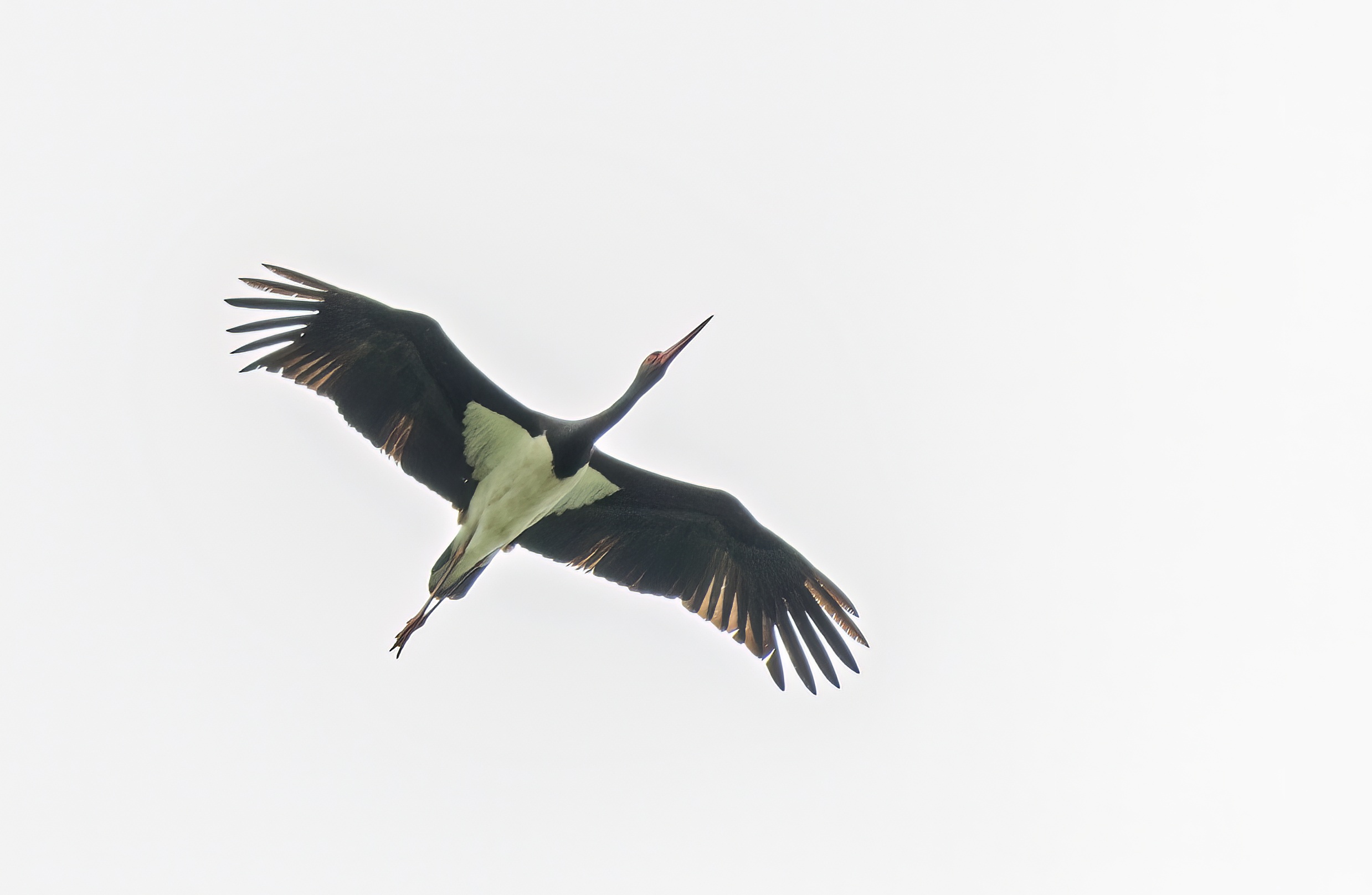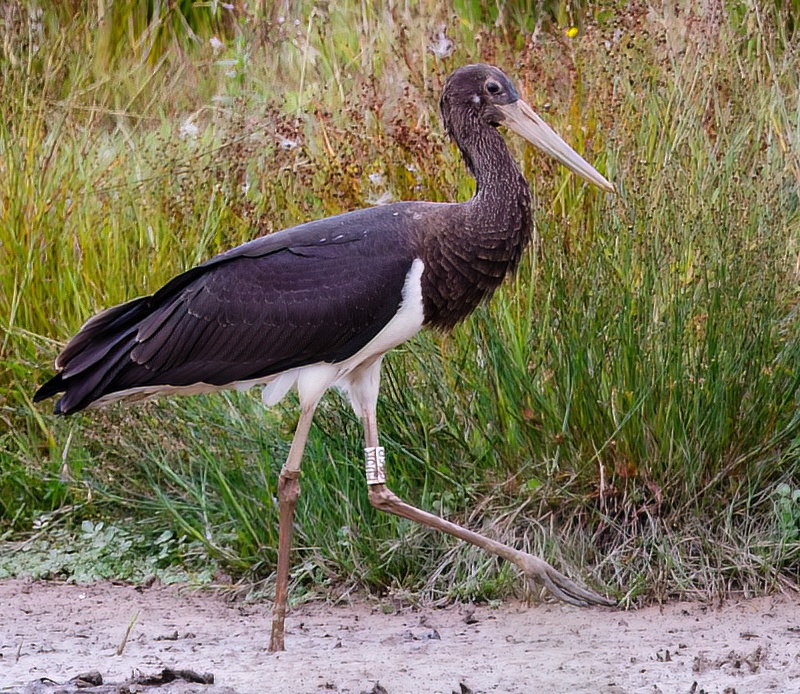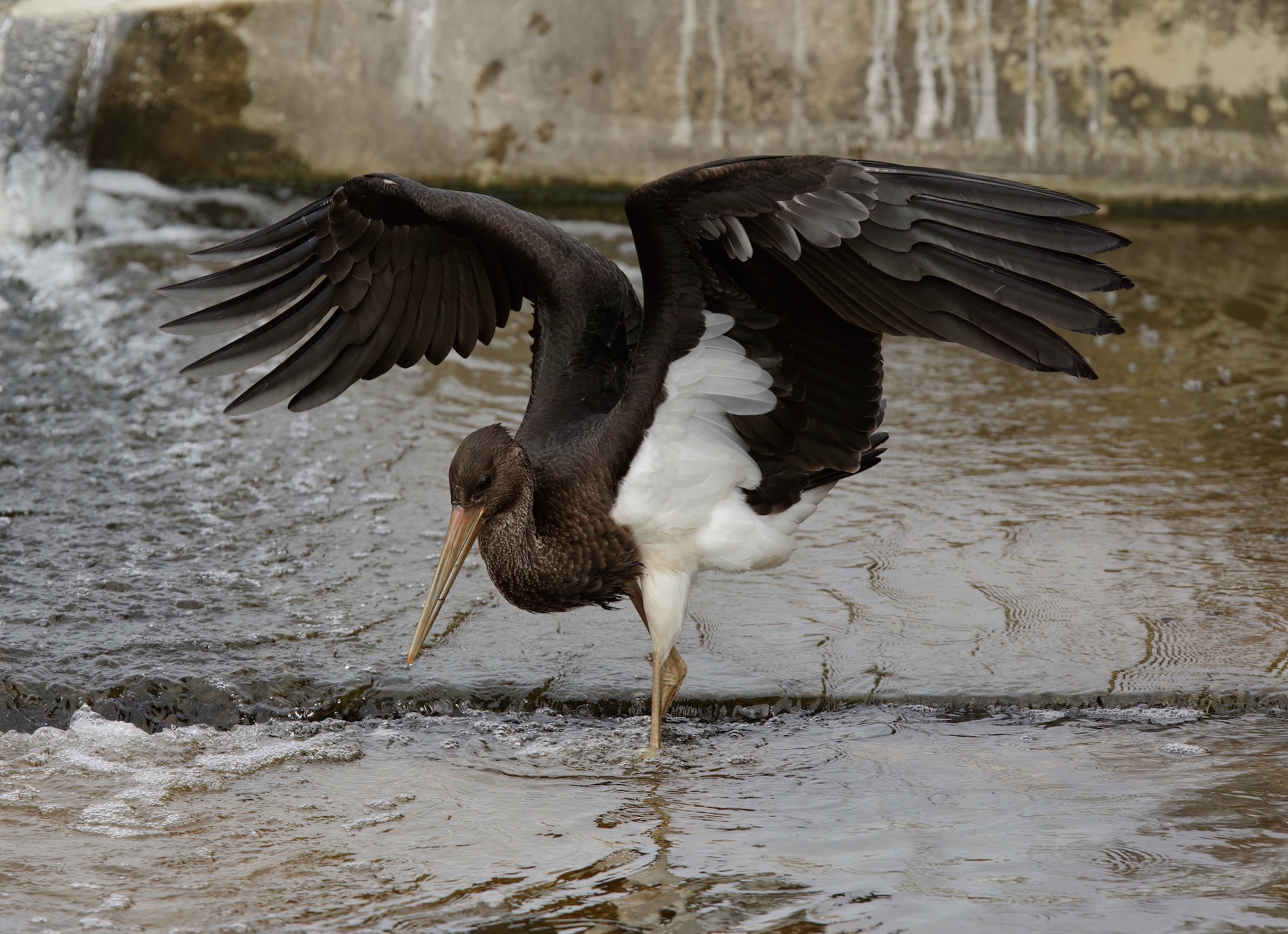Black Stork Ciconia nigra
Rare. Western Europe. First record 1984, recent records reflect the presence of a growing breeding population in northern France.



Black Stork: left, 2CY Crowle Moor May 26th 2014 (Graham Catley); centre, juvenile F05R South Somercotes during its tour of the county August 11th 2015 (John Clarkson)
right, juvenile Dunsby Fen July 25th 2017 (Barry Clarkson).
Only seen for the first time at Freiston Shore in April 1984, there was a gap of 22 years before the second in 2006 since when they have been recorded in 2014, 2015 and 2017. The 2015 records involved at least three wandering individuals seen at many coastal sites, one of which carried colour ring F05R (see below). This bird had been ringed as one of a brood of three in the Ardennes, north-east France. It was the bird last seen Aug 11th and was sadly found dead just north of Madrid, Spain on Oct 20th, 2015. One of its siblings F05P was in north-east Scotland Aug 6th-24th. The 2015 records reflect the presence of a growing population now breeding in northern France and our understanding of the wanderings of the immatures seen in the autumn can be summarised as follows: the first (unringed) individual arrived from Blacktoft Sands (Yorkshire) to Alkborough on August 3rd, and presumably the same individual was at Tetney Marsh later that day and on the 4th when it moved south towards Mablethorpe, being seen at Gibraltar Point on August 5th-12th. Another juvenile flew over Read's Island and up the river Ancholme on August 4th; this is believed to be different from either the first individual which was already on the coast, or the third bird which was still at Spurn. The third individual was a colour-ringed juvenile which had earlier been in the Spurn (Yorkshire) area during August 3rd-10th. This was the bird seen over Covenham Reservoir on August 11th which later that day was seen at North Cockerington and Saltfleet and photographed at South Somercotes when its identity was confirmed with the colour ring F05R. It was later seen in Yorkshire during August 17th-September 13th, apart from September 1st when it appeared over Cleethorpes.
There has been something of a recovery in the northern European population. In France there were just 13 pairs in 2002, but by 2019 they had increased to 60-80 pairs. The Austrian population of just three pairs in 1960 numbered 200–300 pairs by 2002 and breeding birds have returned to Belgium, where there were 31–41 pairs by 2002 and now there are between 100-150 pairs (European Environment Agency Report March 2020).
| Site | First date | Last date | Count | Notes |
| Freiston Shore | 25/04/1984 | - | 1 | |
| Welton-le-Marsh | 20/06/2006 | - | 1 | |
| Crowle Moors | 26/05/2014 | - | 1 | 2CY flew east over Crowle Moors and village, also seen in Yorkshire |
| Frampton Marsh | 22/05/2015 | - | 1 | Flew over the RSPB reserve |
| Boston | 22/05/2015 | - | 1 | Same bird flew over Boston |
| Kirkby GP | 22/05/2015 | - | 1 | Same bird flew NW over Kirkby GP |
| Frampton Marsh & Boston | 19/07/2015 | - | 1 | 1CY+ flew over |
| Tetney Marsh | 03/08/2015 | 04/08/2015 | 1 | 1CY bird over Tetney Marsh and several areas just south of there. |
| Gibraltar Point NNR | 05/08/2015 | 12/08/2015 | 1 | Presumed same 1CY as at Tetney Marsh |
| Covenham Reservoir | 11/08/2015 | - | 1 | 1CY bird, different bird to the previous August 2015 records |
| Dunsby Fen | 24/07/2017 | 25/07/2017 | 1 | 1CY bird |
| Tetney Marsh | 09/08/2021 | - | 1 | 1CY |
| Frampton Marsh | 12/08/2021 | 15/09/2021 | 1 | 1CY, same as Tetney bird; also seen over adjacent areas of The Wash |
| Freiston Shore | 11/08/2023 | 1 | 1CY bird flew in from NE then disappeared towqards Frampton Marsh | |
| Frampton Marsh | 11/08/2023 | 02/10/2023 | 1 | 1CY seen coming in from Freiston Shore direction, assumed same bird; also seen at Kirton Marsh |
Finder’s report: Black Stork at Freiston Shore April 25th, 1984, first county record.
by R. A. Spiers.
Note: account taken from original BBRC submission. This was the only British record of 1984, and BBRC commented that ".. in view of recent breeding records in Belgium and France (Brit. Birds 73: 257; 77: 587) and the high total of 37 in Sweden in 1983 (Brit. Birds 78: 339), British records seem likely to show a continued increase". This prediction has been proven correct with 28 records, 1980-89; 68, 1990-9; 52, 2000-09; and 88 so far, 2010-18.
Circumstances
First seen at 2pm when the bird was about 400m. away on mud banks off the Witham mouth. It was resting when first seen, neck hunched into shoulders and the big red bill was clearly seen when ‘scoped (Optolyth). As the tide came in it stood up and the legs appeared dark in colour and very long; later it became clear that the legs were red in colour when we saw the bird closer. Plumage appeared white below and black on the upperparts; one of us thought that here was brown on the forewing. The bird was pushed off by the tide and settled closer to us on the edge of the mud. When flying the long neck was stretched out and upwards but the feet dangled. All in all, we watched it for about 45 minutes.
Weather
Fine and sunny. Low haze over the water at first, cleared as the tide came in and a breeze got up.
Reference
Rogers, M., J., and the Rarities Committee, with comments by A. R. Dean and K. E. Vinicombe. Report on rare birds in Great Britain in 1984. British Birds 78 (11): 529-589.
(Account prepared November 2017; updated with reference to the new Birds of Lincolnshire (2021), September 2022)

